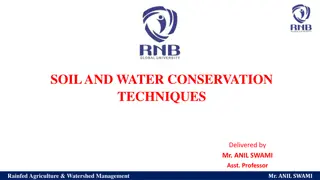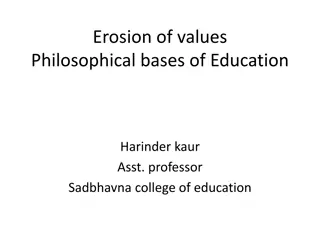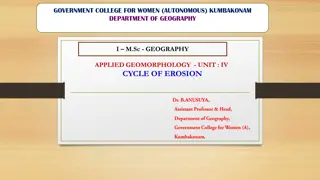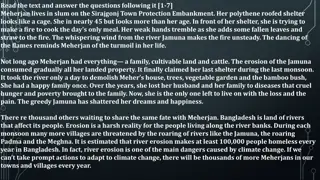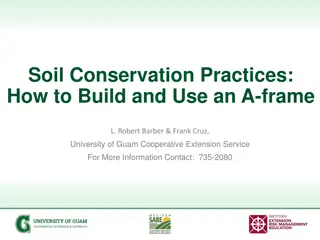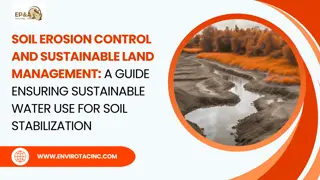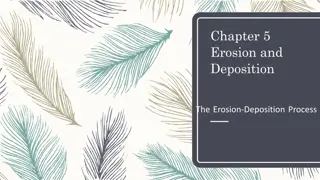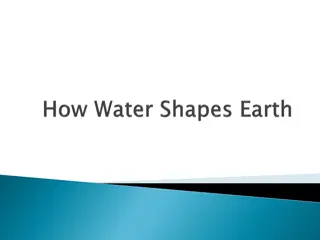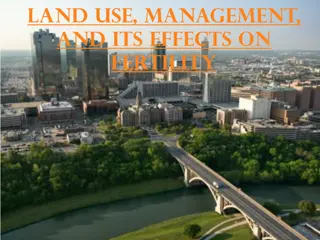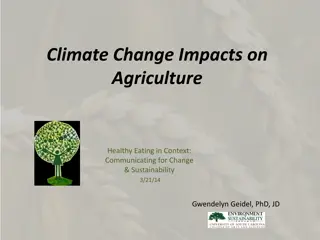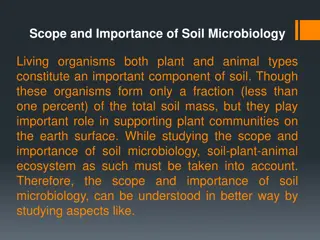Understanding Soil Erosion: Causes, Effects, and Prevention
Soil erosion, the physical removal of topsoil by agents like water, wind, and gravity, poses significant environmental challenges. Erosion affects soil quality, moisture levels, and leads to off-site issues such as sedimentation and pollution. Different types of erosion, including wind, water, and gravity erosion, are driven by various factors like climate, land use, and topography. Awareness of these dynamics is crucial for effective erosion prevention and conservation efforts.
Download Presentation

Please find below an Image/Link to download the presentation.
The content on the website is provided AS IS for your information and personal use only. It may not be sold, licensed, or shared on other websites without obtaining consent from the author. Download presentation by click this link. If you encounter any issues during the download, it is possible that the publisher has removed the file from their server.
E N D
Presentation Transcript
By Sheep pasture with macroscale erosion, Australia Ronald R. Maharaj
Go to fullsize image What is Soil Erosion The word "erosion" is derived from the Latin "erosio", meaning to "to gnaw away". In general terms soil erosion implies the physical removal of topsoil by various agents, including rain, water flowing over and through the soil profile, wind, ice or gravitational pull.
Erosion and Weathering Erosion is distinguished from weathering, which is the process of chemical or physical breakdown of the minerals in the rocks, although the two processes may be concurrent.
On site and Off site The consequences of soil erosion can be seen both on- site and off-site. Go to fullsize image Go to fullsize image
On site On-site effects are the loss of soil, the breakdown of the soil structure and a decline in organic matter. Erosion also reduces available soil moisture, resulting in more draught-prone conditions. Go to fullsize image
Off Site Off-site problems result from sedimentation downstream or downwind which reduces the capacity of rivers and drainage ditches, increases the risk of flooding, blocks irrigation canals and shortens the design life of reservoirs. Eroded sediment is also a pollutant, the chemicals absorbed by it can increase the levels of nitrogen and phosphorus in water bodies and result in eutrophication.
Types of Soil Erosion Wind erosion: Wind erosion is the removal soil particles by the force and kinetic energy of the wind. These soil particles are transported and deposited when the wind energy drops. Water erosion: Water erosion is caused by the kinetic energy of rain falling on the soil surface and by the mechanical force of runoff. Gravity erosion: Mass movement of soil occurs on steep slopes under the influence of gravity. The process involves the transfer of slope-forming materials from higher to lower grounds due to self weight.
Causes of Soil Erosion Climatic Factors Land use by man Soil itself Hydrology Landform and topography Go to fullsize image
Climatic Factors The two most important climatic factors having a direct effect on erosion are precipitation and wind velocity. Other climatic factors have an indirect effect on soil erosion, such as water balance, evapotranspiration, temperature and relative humidity. Indirect factors affect the erosivity of rainfall by altering the soil moisture regime and the proportion of rainfall that may become surface runoff.
Land Use Humans play a major role in soil erosion through their use and abuse of natural resources, for example deforestation, grazing, arable land use, faulty farming systems, high crop intensity, housing construction, mining etc. Go to fullsize image
Soil Itself The susceptibility of a soil to erosion is influenced by its physical, hydrological, chemical and mineralogical properties as well as its soil profile characteristics. Important soil physical and hydrological properties that affect the resistance of a soil to erosion include texture, structure, water retention and transmission properties.
Hydrology Infiltration, surface detention, overland flow velocity, and subsurface water flow are important soil erosion components of the hydrological cycle. The different types of flow and their velocities may be turbulent or laminar, steady or unsteady, uniform or non-uniform and influence the extent of erosion
Topography Slope gradient, slope length and shape of slope are the important variables of landform that affect erosion processes for all types of soil erosion, e.g., splash, sheet, rill, and gully erosion.
Soil Conservation Soil is effectively a non-renewable resource because erosion occurs at rates that outpace soil formation. Artificial soil formation is impractical, so we have little choice but to conserve the soil we have to ensure a continued supply of agricultural products.
Techniques Modern techniques include - contour plowing - terracing - crop rotation - shelter belt
Other Techniques Afforestation Using organic fertilisers Using stubble and mulch Practicing Intercropping alternative strips of taller and shorter plants can lift the wind over the land surface and cut down the amount of soil blown away. Cut down on overgrazing
And Other Techniques Reduced tillage No tillage Water harvesting But, what is tillage?
Howse brand modular Subsoiler mounted to a tractor Tillage Tillage is the agricultural preparation of the soil by ploughing, ripping, or turning it. Tillage can also mean the land that is tilled. There are two types of tillage: primary and secondary tillage. Primary tillage loosens the soil and mixes in fertilizer and/or plant material, resulting in soil with a rough texture. Secondary tillage produces finer soil and sometimes shapes the rows. It can be done by a using various combinations of equipment: plough, harrow, dibble, hoe, shovel, rotary tillers, subsoiler, ridge or bed forming tillers and roller.
Water Harvesting Water Harvesting is capturing and storing rainfall to irrigate plants or to supply people and animals. It is one of the oldest known gardening methods, dating back to the beginnings of agriculture. Water harvesting will help you save money on monthly water bills and reduce your dependence on municipally-supplied water. A well-designed system will also decrease your landscape maintenance needs.



